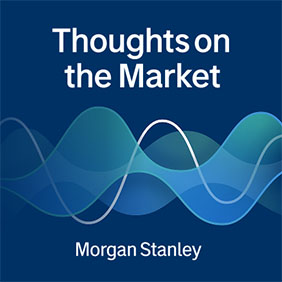How Japan’s Stablecoin Could Reshape Global Finance
October 31, 2025
Our Japan Financials Analyst Mia Nagasaka discusses how the country’s new stablecoin regulations and digital payments are set to transform the flow of money not only locally, but globally.

Thoughts on the Market
Listen to our financial podcast, featuring perspectives from leaders within Morgan Stanley and their perspectives on the forces shaping markets today.

Up Next
Why Shutdown Standoff Raises Stakes for Healthcare
Transcript
Ariana Salvatore: Welcome to Thoughts on the Market. I'm Ariana Salvatore, Morgan Stanley's U.S. Public Policy Strategist.
Erin Wright: And I'm Erin Wright, U.S. Healthcare Services Analyst.
Ariana Salvatore: Today we'll talk about what the U.S. government shutdown means for healthcare.
It's Thursday, October 30th at 12pm in New York.
Thus far, it seems like markets haven't really been paying too much attention to the government shutdown.
Obviously, we're aware of the cumulative economic impact that builds every week that it lasts. But we haven't seen any movement from the political front either this week or last, which signals that it could be going on for a while longer. That being said, the end of this month is an important catalyst for a few reasons.
First of all, you have the potential rollover of SNAP benefits. You have another potential missed military paycheck. And most importantly, the open enrollment period for healthcare plans. Polling is still showing neither side coming out on top with a clear advantage.
Absent that changing, you probably need to see one of two things happen to have any movement forward on this front. Either more direct involvement from President Trump as he wraps up the APEC meeting or some sort of exogenous economic event, like a strike from air traffic controllers.
Those types of events obviously are difficult to predict this far in advance. But up until now we know that President Trump has not really been involved in the debate. And the FAA seems to be operating a little bit with delays, but as usual.
So, Erin, let's pivot to what's topical in here. From a healthcare policy perspective, what are investors that you speak with paying the most attention to?
Erin Wright: You bring up some important points Ariana. But from a policy perspective, it's very much an always top of mind for healthcare investors here. Right now, it is a key negotiating factor when it comes to the government shutdown.
So, the shutdown debate is predominantly centered around the Affordable Care Act or the healthcare exchanges. This was a part of Obamacare. It was a program where individuals can purchase standalone health insurance through an exchange marketplace.
The program has been wildly popular; in recent years with 24 million members. Growing 30 per cent last year, particularly with enhanced subsidies that are being offered today. So those subsidies are expected to expire at the end of this year, and those exchange members could be left with some real sticker shock – especially when we're going to see premium increases that could, on average, increase about 25 to 30 percent, in some states even more.
So, folks are really starting to see that now. November 1st will be a key date here as open enrollment period begins ends.
Ariana Salvatore: Right. So, as you mentioned, this is pretty key to the entire shutdown debate. Republicans are in favor of letting the expanded subsidies roll off. Democrats want to restore them to that COVID level enhancement. Of course, there's probably some middle path here, and we have seen some background reporting indicating that lawmakers are talking about a potential middle path or concession. ,
So, talk me through what's on the table in terms of negotiating a potential compromise or extension of these subsidies.
Erin Wright: So, we could see a permutation of outcomes here. Maybe we don't get a full extension, but we could see something partial come through. We could see something in terms of income caps, which restrict kind of the level of participants in the AC exchanges. You could see out-of-pocket minimums, which would eliminate some of those shadow members that we've been seeing and have been problematic across the space. And then you could also grandfather in some existing members that get subsidies today.
So, all of those could offer some degrees of positive and some degrees of relief when it comes to broader healthcare services, when it comes to insurance companies, when it comes to others that are participating in this program, as well as the individuals in themselves. So, it's really a patient dynamic that's getting real here.
A lot is on the table, but a lot is at stake with the potential for the sunsetting of these subsidies to drive 4 million in uninsured lives. So, it is meaningful, and I think that that's something we have to kind of put into perspective here.
So, would love to know Ariana though, beyond healthcare, what are some of those key debates in terms of the negotiations around the shutdown?
Ariana Salvatore: Healthcare really is central to this debate. So aside from just the ACA subsidies that we talked about, some Democrats have also been pushing for a repeal or rollback of some of the pieces of the One Big Beautiful Bill Act that passed earlier this year. That was the fiscal bill of Republicans – passed through reconciliation process – that included some cuts to Medicaid down the line. So, there's been talk around that front.
I think more of a clear path on the subsidies front, because that seems to be something that Republicans are treating as an absolute no-go. Some of the other really key debates are around just kind of how to keep the ball rolling while we're still in the shutdown.
So, I mentioned SNAP at first, the potential release of some contingency funds there. Again, the military paychecks are really critical. And, of course, what this all means for incoming data, which is really important – not just for investors but also for the Fed, as it kind of calibrate[s] their next move. In particular, as we head into the December meeting, I think we got a little bit of a hawkish surprise in yesterday's meeting, and that's something that investors were not expecting.
So, obviously the longer that this goes on, the more those risks just continue to grow, and this deadline that we're talking about is a really critical one. It's coming up soon, so we should have a sense of how our prognosis pans out in the coming days.
Thanks for the conversation, Erin.
Erin Wright: Great talking to you, Ariana.
Ariana Salvatore: And to our audience, thanks for listening. Let us know what you think by leaving us a review wherever you listen. And if you like Thoughts on the Market, tell a friend or colleague about the podcast today.

M&A Poised to Gain Momentum
Transcript
Andrew Sheets: Welcome to Thoughts on the Market. I'm Andrew Sheets, Head of Corporate Credit Research at Morgan Stanley.
Today – a discussion of merger and acquisition activity or M&A. Last year, we had a view that this activity would pick up significantly. We think we're seeing that increase now. It has further to go.
It's Wednesday, October 29th at 2pm in London.
We have been firm believers at Morgan Stanley in a significant multi-year uplift in global merger and acquisition activity or M&A. That conviction remains. The incentives for this type of action are strong in our view; activity still lags what fundamentals would suggest, and supportive regulatory shifts are real.
M&A has now returned, and importantly, we think there's much further to go. Indeed, M&A is very closely linked to corporate confidence, and we think investors need to consider the possibility that we'll see an even bigger surge in this confidence – or a boom.
First, policy uncertainty is declining as U.S. tax legislation has now passed, and tariff rates get finalized. It's the relative direction of this uncertainty that we think matters most for corporate confidence.
Second, interest rates are declining with the Fed, European Central Bank, and Bank of England all set to cut rates further over the next 12 months. Third, bank capital requirements may decline in the view of Morgan Stanley analysts, which would unlock more lending for these types of transactions.
Fourth, and very importantly, the regulatory backdrop is becoming more accommodative in both the U.S. and in Europe. Indeed, we think that companies may think that this is going to be the most permissive regulatory window for transactions that they might get for some time. Fifth, private equity, which is a big driver of M&A activity, is sitting on over $4 trillion of dry powder in our view – at a time when credit markets look very wide open for financing their transactions.
And finally, we're seeing a surge in capital expenditure on Morgan Stanley estimates, which we see as a sign of rising corporate confidence, and importantly an urgency to act – with corporates far less content to simply sit back and repurchase their stock.
All of these favorable conditions together argue for activity to push even higher. We forecast global M&A volumes to increase by 32 percent this year, an additional 20 percent next year, and reach $7.8 trillion in volume in 2027.
This is a global story with M&A rising across regions, especially in Japan. It has cross-asset implications with M&A already being one of the biggest drivers of bond outperformance within the U.S. high-yield market. And this is also a story where we see a lot of value in bringing together macro and micro perspectives.
While we think the top-down conditions look favorable for all the reasons I just mentioned, we also see a very encouraging picture bottom up. We polled a large number of Morgan Stanley sector analyst teams and asked them about M&A conditions in their sector. A large majority of them see more activity.
So, where could these more specific implications lie? Well, as you heard on yesterday's episode, Healthcare and Biotech may see an uptick in activity. In the U.S., we also think that Banking and Media stand out. In Europe, Business Services, Metals and Mining, and Telecom seem most ripe for more M&A.
Aerospace and Defense is an interesting sector that may see more M&A within multiple regions, including the U.S. and Europe, as companies look for scale. And with smaller companies trading at a valuation discount to their larger peers across the world, Morgan Stanley analysts generally see the strongest case for activity in larger companies acquiring these smaller ones.
Thank you as always for your time. If you find Thoughts on the Market useful, let us know by leaving a review wherever you listen, and also tell a friend or colleague about us today.

Sign up to get Morgan Stanley Ideas delivered to your inbox.
Thank You for Subscribing!
Would you like to help us improve our coverage of topics that might interest you? Tell us about yourself.



